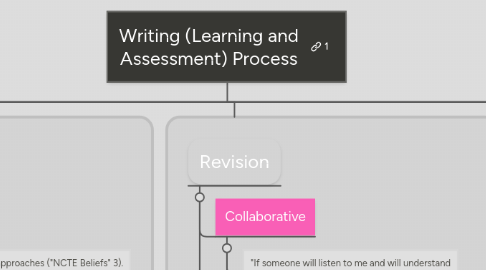
1. Mindset
1.1. Growth
1.1.1. Everyone can get better at writing" ("NCTE Beliefs" 1).
1.1.1.1. Carol Dweck
1.2. Character Strengths
1.2.1. Curiosity
1.2.1.1. Fostering interest in the world and in learning.
1.2.2. Optimism
1.2.2.1. Self-talk: "My effort will improve my future."
1.2.3. Grit
1.2.3.1. Angela Duckworth
1.3. Teacher is also learner
1.3.1. Teachers learn through their own creative struggles (Borton and Huot 5, Elbow 2-3)
1.3.2. Celebrate what students have to teach (NCTE "Multimodal" 2, 3).
2. Reading
2.1. Throughout the writing process.
2.1.1. Reading to write better, writing to read better, reading to learn about audience and context ("NCTE Beliefs" 5).
2.2. Model texts
2.2.1. Stylistic relevance
2.2.2. Topic relevance
2.2.3. Mode relevance
2.3. Peer texts
2.3.1. To celebrate
2.3.2. To give feedback
2.3.3. To learn from one another
3. Drafting
3.1. Flexible
3.1.1. Explore varied approaches ("NCTE Beliefs" 3).
3.1.1.1. Include speaking in the drafting process ("NCTE Beliefs" 6).
3.1.1.2. Collaborative drafting is a valuable and relevant experience (NCTE "Multimodal" 2).
3.1.2. "Forging into the unknown...eventually [leads] to clarity"(Elbow 4).
3.1.3. CCSS.ELA-LITERACY.CCRA.W.5
3.2. Relevant
3.2.1. Topics that matter to the writer (Sommers "Re-Visions" 251)
3.2.2. Topics that matter to the world
3.3. Frequent
3.3.1. Write a lot, for many different purposes.
3.3.2. CCSS.ELA-LITERACY.CCRA.W.10
3.3.3. "People learn to write by writing" ("NCTE Beliefs" 1).
3.3.4. "You can't write anything unless you generate a lot, a lot, a lot" (Elbow 5).
4. Revision
4.1. Collaborative
4.1.1. "If someone will listen to me and will understand me, I'll be able to say what I'm trying to say better" (Elbow 8).
4.1.2. "Ally readers" to support risk-taking (Elbow 9, 11)
4.2. Guided
4.2.1. Mini-lessons
4.2.1.1. "What can I do today to help you make your paper better?" (Gallagher 155)
4.2.2. Models
4.2.2.1. Provide professional and student models and discuss what works, how to improve.
4.2.3. Focused practice
4.2.3.1. Practice a single skill in a low-risk, high-support environment, then apply immediately to draft.
4.3. Cyclical
4.3.1. "Writing is never finished, it's just due" (Gallagher 166).
4.3.2. Depends on authentic audience: revision is only worthwhile if we care about who will ultimately read.
5. Publishing
5.1. Authentic
5.1.1. Authentic audiences provide purpose and motivation for writing, revising, and editing.
5.1.2. "When writing only takes place in school, that's what makes writing hard" (Elbow 17).
5.2. Multimodal
5.2.1. Technology makes immediate, affordable, global publication possible (NCTE "Multimodal" 3).
5.2.2. Multimodal writing impacts content, process, and learning (Borton and Huot 5, "NCTE Beliefs" 7-8).
5.2.3. CCSS.ELA-LITERACY.CCRA.W.6
6. Focused
6.1. Skill-based
6.1.1. "Teach one lesson at a time" (Sommers "Re-Visions" 253).
6.1.2. "One central goal: everyone improves" (Gallagher 142).
6.2. Transferrable
6.2.1. Skills build and improve grade across multiple drafts and compositions (CCCC "Writing Assessment" 2).
6.2.2. "Show students how to do something differently the next time" (Sommers "Re-Visions" 253).
6.3. Growth-mindset
6.3.1. See students as "capable of great things, even if not yet achieved" (Sommers "Re-Visions" 252).
7. Collaborative
7.1. Conferences
7.1.1. "You can achieve more in a two-minute conference than you can by spending five to seven minutes writing comments on a paper" (Gallagher 167).
7.1.2. Based on student needs and questions (Gallagher 163)
7.2. Workshops
7.2.1. Provides authentic audience (Borton and Huot 6)
7.2.2. Well-run, provides safety for risk-taking
7.2.2.1. Celebrate and learn from what works
7.2.2.2. Teach strategies for fixing what doesn't work
7.3. Rubrics
7.3.1. "Clearly communicate what is valued and expected" (CCCC "Writing Assessment" 3, NCTE "Multimodal" 2).
7.3.2. Built with student input (Borton and Huot 3)
7.3.3. Self-assess (CCCC "Writing Asessment" 2)
7.3.4. Peer-assess (CCCC "Writing Asessment" 2)

